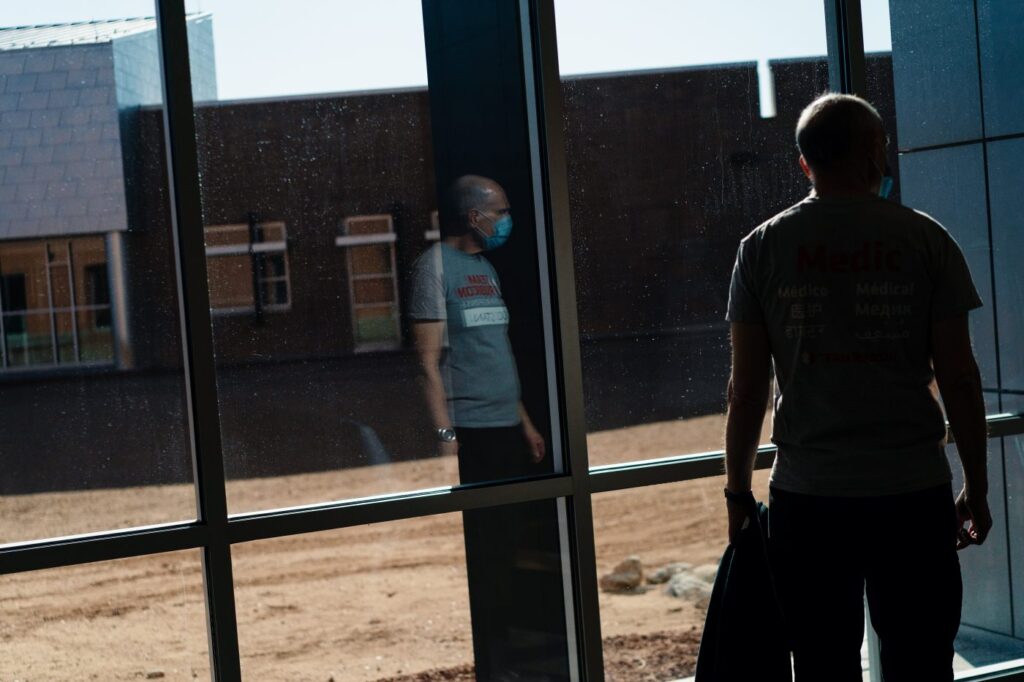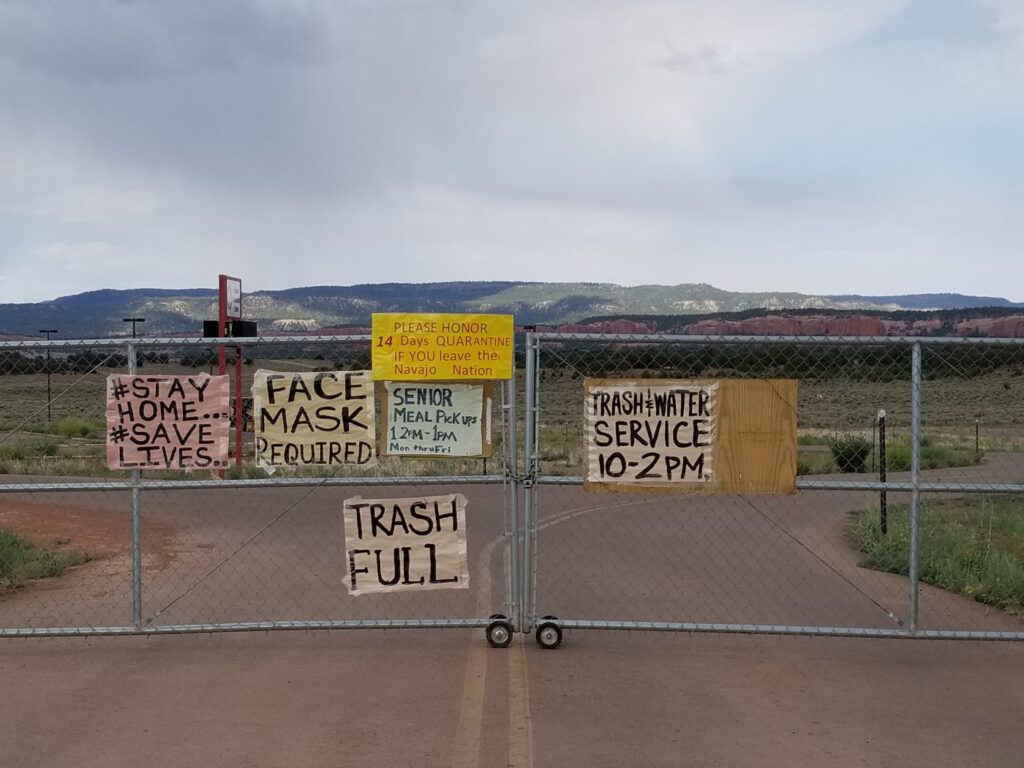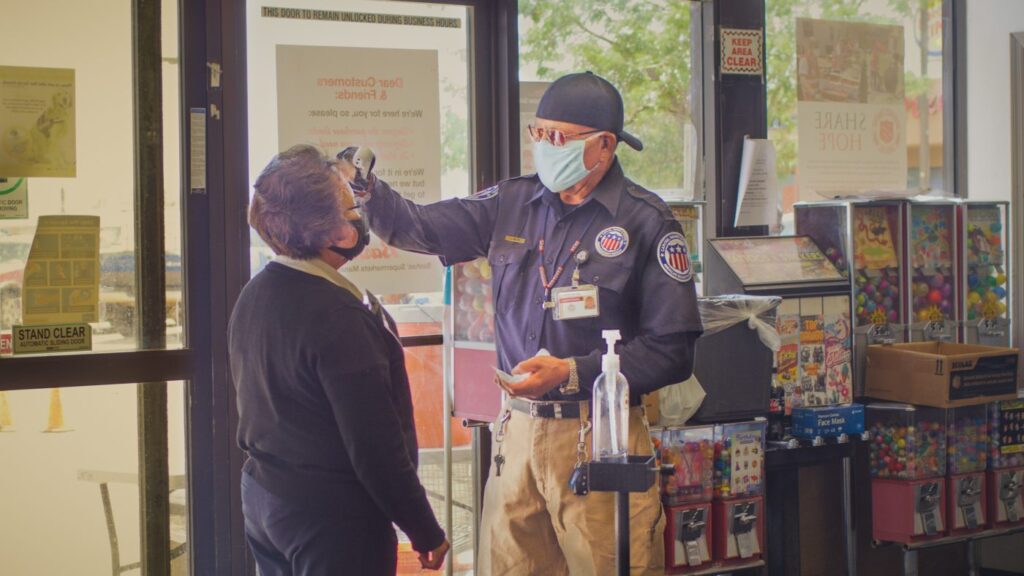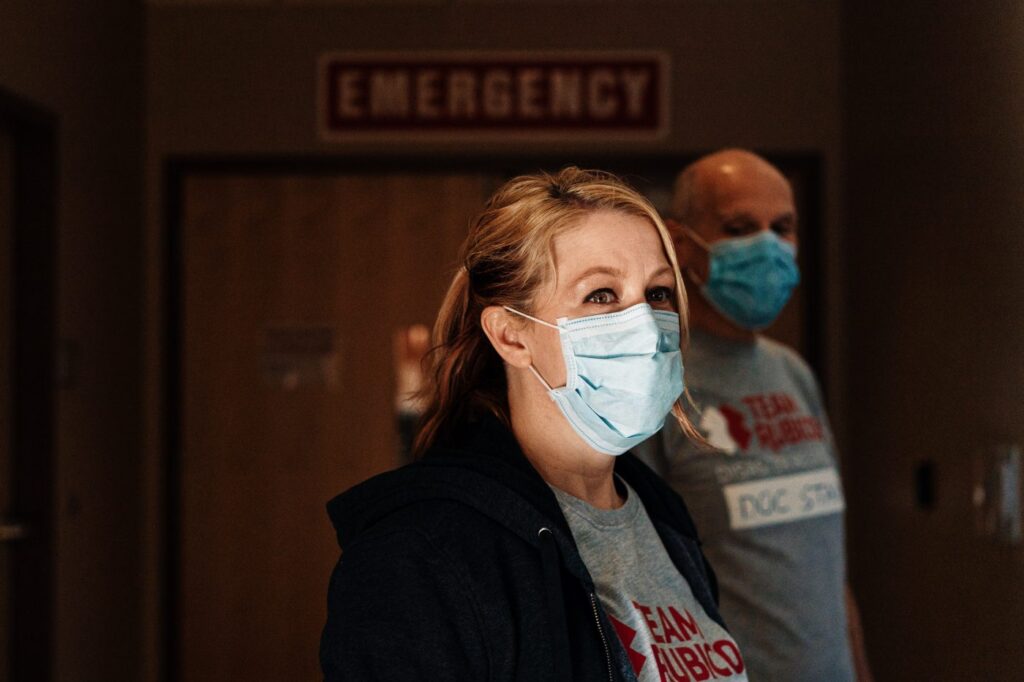The novel Coronavirus began creeping onto the Navajo Nation in early March, but its invisible presence wouldn’t be fully felt for weeks. At first, the Nation seemed to have avoided the virus, even as surrounding states started to experience its effects. But when a handful of people arrived at the hospital in Kayenta with a strange pneumonia, doctors knew something wasn’t right.
“From that day on, that’s when they realized COVID had finally hit the reservation, and since then it’s kind of been tearing through the community,” said Keegan Bradley, an emergency medicine physician at Atrium Health’s Carolinas Medical Center in Charlotte, North Carolina who deployed to Kayenta, Arizona, with disaster relief non-profit Team Rubicon for two weeks to serve alongside doctors from Indian Health Services treating patients experiencing coronavirus symptoms.
The first known cases of COVID-19 on the Navajo Nation popped up near Kayenta, Arizona, around March 17 carried by someone returning from a basketball tournament in Tucson. As the number of positive cases began to rise so did the number of deaths.

Team Rubicon volunteer Dr. Stan Chartoff walks to the emergency department of the Kayenta Health Center. (Photo by Carolyn Kaster)
From April 23 to May 6, Bradley said he’d see about eight patients a day. While that number may seem low, the people he was seeing had very serious COVID-19 symptoms.
“At least one or two every day came in sick enough that we, unfortunately, had to intubate them or put them on a ventilator because they were breathing too fast and they were too unstable,” Bradley said. “There was concern that they would go downhill on us.”
Coming from North Carolina, Bradley said he hadn’t seen quite as much of the virus as doctors in other states, like New York, had. His arrival to the Navajo Nation changed that.
“At least 50 percent of the people coming in were for COVID symptoms,” Bradley said.
At about 27,000 square miles and spanning parts of New Mexico, Arizona, Utah, and bordering Colorado, the Navajo Nation is the largest Native American reservation in the U.S. Vast and often remote, the reservation is made up of small scattered communities where sometimes the nearest gas station is miles away.
According to a December 2013 report from the Navajo Epidemiology Center based on 2010 Census data, approximately 156,823 Navajos live on the reservation, and there are more than 300,000 enrolled tribal members, making the Navajo tribe the second largest in the country behind the Cherokee tribe. As of Tuesday, July 7, more than 60,300 tribal members had been tested for the coronavirus, with 7,941 testing positive, 5,650 recovered, and 379 deceased, according to data from the Office of the President and Vice President of the Navajo Nation.
Curfews, Loudspeakers, and Sounding the Call for Running Water
To slow the spread of the virus, March 30, Navajo Nation President Jonathan Nez was forced to create a nightly curfew. Soon, with the virus gaining strength, President Nez would also implement a 57-hour weekend lockdown that would run from 8 p.m. Friday to 5 a.m. Monday. Anyone out of their home for a non-emergency could be issued a citation as well as a fine of up to $1,000 and 30 days in jail. Meanwhile, the Navajo Nation Police Department drove through neighborhoods with a loudspeaker encouraging people to stay home and wash their hands.
When the virus forced schools to close and the tribal government to shut down, life on the Navajo Nation started to shift. Only a few cars traveled the normally busy roadways, and only essential employees were allowed to return to offices. Everybody else went online. The Navajo Tribal Utility Authority set up wireless connection spots in communities for those who didn’t have internet at home, and conversations about the lack of electricity and water in underserved areas became priorities again.
As the Coronavirus Gains Ground, Community Suffers
Meanwhile, the way of life was changing across the Nation. Many tribal members who count on income made selling firewood along the road had to suspend their operations. Roadside food stands and flea markets across the reservation closed. Flea markets are a big weekend event for many, who walk around and shop for second-hand clothes, food, snow cones, and Navajo snacks like blue corn mush, tamales, and mutton sandwiches. It is also a place to find unique Navajo made medicines, t-shirts, skirts, and jewelry from local vendors. The flea market for many Navajos is a gathering area, one where you’d connect with friends and family.

Navajo Nation police at a COVID-19 checkpoint near Kayenta, AZ.
As the virus encompassed the Nation, lakes and other outdoor areas closed and events slowly started to get canceled. What everyone thought would be a two-week quarantine turned into a month, then two months, and soon fair season was on the chopping block. On the Navajo Nation, fair season is a time for communities to celebrate, and for many tribal members to travel from out of town to visit family and friends they may not have seen for a while. The largest American Indian fair and rodeo within the Southwest U.S., the Navajo Nation Fair, takes place in Window Rock in early September every year. When it comes to town, Window Rock is almost impossible to drive through: The fair typically draws a crowd of 15,000 people daily for its popular music acts, rodeo, and parade. With those crowds also comes a financial boost to restaurants, grocery stores, and small local vendors, including those at the flea market and roadside stands selling handmade jewelry, art, food, and crafts.
Navajos aren’t just losing their ability to gather at fair time or at the flea market, they have also lost their ability to see family. The graduation celebrations, the Mother’s Day and Father’s Day gatherings were halted in hopes of slowing the spread. And, while the weekend and nightly curfews are designed to keep the community safe, many saw it as a lost opportunity to visit family who they were used to seeing every week. Now, many families haven’t seen each other in months.
Navajo Nation Curfew Means No Escape for Many
As the virus spread, businesses across the reservation were forced to create new hours and new policies in hopes of keeping customers and workers safe. Restaurants closed and soon the drive-thru lanes at local banks and fast-food chains had lines of vehicles snaking around buildings and spilling into other parking lots.
When grocery stores first adjusted to one entrance and one exit, with a limited number of shoppers allowed in the store at a time for social distancing, people began lining up outside. Because weekends are when many Navajos grocery shop, when the curfew was implemented many people rushed the local grocery stores on Fridays and Mondays. Some even bee-lined to nearby border towns to get their shopping done before the weekend shut-in began.
 The new 57-hour curfew created an additional challenge: no weekend travel except for emergencies meant no trips to Gallup, Albuquerque or Phoenix where many Navajos travel to see family, and to escape the reservation for a few days.
The new 57-hour curfew created an additional challenge: no weekend travel except for emergencies meant no trips to Gallup, Albuquerque or Phoenix where many Navajos travel to see family, and to escape the reservation for a few days.
President Nez also had to create a plan for first-of-the-month shopping which, on the Navajo Nation, can mean thousands of people out at the same time trying to get their shopping done. For many Navajos, first-of-the-month checks are either their only income or their biggest source of income, and many of the recipients are elderly. When the checks arrive, many elderly Navajos have family take them to Gallup or Window Rock to pay bills, buy groceries, and sometimes to do laundry or eat out. In order to keep those more at risk safe, local grocery stores had to create special hours for the elderly in hopes they would curb infection rates.
In Prime Season, Navajo Food Providers Take a Hit
For bakeries and food providers, the virus also changed a lot in the way of everyday production and preparation.
“We’re having to really dig in deeper to find out what’s going to sell, what’s not going to sell, what we need to put out, how much we need to put out … We really have to fine-tune everything,” explained Malcolm Willie, bakery manager at Bashas’ in Crownpoint, New Mexico.
The biggest hit for the bakery came during graduation season.
“That’s like our Super Bowl in a way,” said Willie. “That’s the one thing us reservation stores prepare for.” Canceled graduation parties weren’t the only obstacle, there was also the 57-hour weekend curfew.

Many restaurants within the Navajo Nation are shuttered due to the coronavirus.
“We’re having to turn customers away from ordering weekend stuff,” Willie said. While weekends are typically a busy time for the bakery, the curfew means no made-fresh-daily cakes on Saturdays and Sundays. Many customers aren’t willing to buy a cake on Friday to be saved for a Sunday dinner, Willie explained. Big pastries are also getting pared down, with locals ordering smaller cakes instead. Willie takes this as a good sign that family gatherings are staying small, and which is important in slowing the spread of the virus.
Meanwhile, Willie has begun some custom cake production. His team began making cakes featuring animals such as Churro sheep—sheep are sacred to the Navajo people—wearing face masks, which quickly became bestsellers. His team also created cakes that say, “Stay Home, Stay Safe,” in attempts to provide support, and hopefully smiles, to a community facing among the highest per-capita COVID-19 infection rates in the U.S.
Outside of work, Willie and his family—he and his girlfriend have three kids under age 7—focus on staying safe. The kids haven’t been inside a store since this virus started three months ago. Once in a while, he sneaks them out for ice cream but it’s always drive-thru, and he makes sure the family never leaves home without a mask and hand sanitizer.
“Before all this happened we would go into town, treat out the kids or buy them clothes and shoes and stuff but we can’t do that now. We can’t take them inside anywhere,” he said.
Tough Choices: Sacrificing Personal Safety for Supplies
When shopping for groceries, Willie himself doesn’t travel the 36 miles to Gallup, New Mexico, a hot spot for the virus, but instead drives 55 miles to Grants, New Mexico.
“I don’t want to catch it and bring it back to my family,” he said. “That’s the main thing on my mind right now.”

Temperature checks become common at local grocery stores.
Willie is among the lucky: not everyone has the option of driving off the reservation for groceries and supplies, as many lack transportation. Instead, they must forgo social distancing and rely on family or friends for a ride into town to get supplies—if they are able.
And, while there have been numerous food and supply drives on the reservation by the tribal government and outside entities from other states, sometimes those most in need can’t access them because they don’t know about them, or because they lack transportation.
Willie understands that the virus isn’t something that can be controlled or even fully planned for and that everybody is trying to do their best. So, he continues to provide a shoulder to lean on for his employees and takes advantage of the time with his family. And though he still longs for family trips he knows it’ll be a while before he can take another one.
“As long as these places are bringing in positive cases, I guess that’s the answer for us not to go out,” Willie said.
Doctors Tackle Unique Coronavirus Challenges—and Lose One of Their Own
For IHS physicians and volunteer doctors such as Bradley, treating patients on the reservation has been tricky due to limited resources. There are few to no specialists and no extra rooms to keep patients in, Bradley said. When Bradley arrived, the Kayenta emergency department had just 10 beds, one radiology suite, one lab, one trauma resuscitation room, and one isolation room.
“Anything you couldn’t solve in the emergency department and send home you had to basically fly out,” he said, adding that the nearest hospital was about four hours by ambulance. “It’s always a risky thing when you have to fly out people on a ventilator who are as sick as some of the patients we saw.”
Patients were flown to hospitals in Flagstaff and Tuba City, Arizona, unless those hospitals were full.
As the virus continued to spread with vengeance, so did the severity of those coming in with it. One minute a patient looked fine; the next they were turning blue and struggling to breathe, Bradley said.

Team Rubicon at the Kayenta Health Center.
The most common symptoms the medical staff saw were respiratory. Patients in the 60-year-old age range were common, but so were people with obesity and diabetes. Children were a rarity.
“It definitely weighs on you because people are sick, your resources are limited out here, and you’re trying to do the best you can for them to make sure you keep them alive,” Bradley reflected.
If patients weren’t critical then they were sent home, but Bradley knew they were being sent home to houses that were filled with family. Many Navajo homes consist of three generations living together. Such housing density often causes the virus to rapidly spread.
While Bradley was fighting to save the lives of people in the community that he’d never met and may never see again, he was happy to help in any way he could. Soon, however, the virus would get personal. An ER nurse came in with the virus and needed to be intubated. Soon, she was being flown out herself. Just days earlier, the doctor and nurse had been laughing together and eating Navajo tacos. Then, just like that, the virus had taken away a new friend.
“It changes your perspective pretty significantly once you experience it and you realize how dangerous the disease can be, and how underestimated it is at times,” Bradley said.



